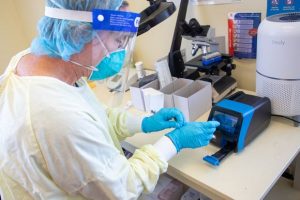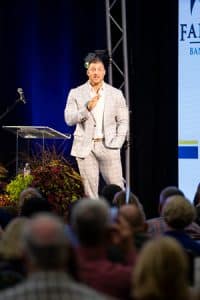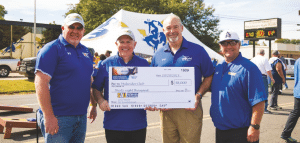Keeping students, faculty and staff safe and healthy is what kept SAU’s campus open during the fall semester. Accomplishing that took a lot of teamwork from several different departments. A reopening task force was established early on to determine what processes the University needed to follow to bring students back to campus and how to manage positive cases.
University Health Services – first step to keeping campus healthy
 Meeting students’ needs and keeping the campus safe are top priorities for University Health Services (UHS) and University Housing during the pandemic. Both departments work diligently to slow the spread of the COVID-19 virus on campus and create a positive academic and living environment.
Meeting students’ needs and keeping the campus safe are top priorities for University Health Services (UHS) and University Housing during the pandemic. Both departments work diligently to slow the spread of the COVID-19 virus on campus and create a positive academic and living environment.
Dr. Trey Berry, SAU’s president, has offered praise for the heroic work of all faculty and staff who collaborated on safety procedures and protocols for the campus. These include not only UHS and Housing but the Risk Management and Re-Opening committees.
“What heroes we have,” Berry said. “They have done everything imaginable to keep us safe.”
One crucial early decision in the fight against COVID-19 was to purchase two Rapid Testing machines over the summer. By the fall semester, more than 1,900 tests had been conducted using the devices.
“There’s no doubt the machines helped us keep the campus safe and healthy,” said Berry.
UHS has two SOFIA 2 SARS antigen testing machines that provide fast, accurate results to control the spread of COVID-19.
The machines are part of SAU’s overall endeavor to limit the virus’s spread, perform contact tracing, and increase safety. This has allowed UHS to offer many testing clinics for various campus populations as needed with quick results.
“Purchasing the machines was an important move for us,” said Dr. Donna Allen, vice president for student affairs, “but we knew it would be critical in keeping students, faculty and staff safe, which is our highest priority.”
The University purchased the machines in early July, putting SAU ahead of the curve in on-campus testing. Amanda Hanson, UHS director, said all clinic nurses are trained on the devices. Nurses test directly for viral components, detecting active infection instead of antibodies that indicate past infection. Antigen testing, such as this, can be done quicker than many other PCR tests, with similar accuracy and at a better cost to the University and its students.
Hanson said testing is available to students without requiring them to come into the clinic office. Drive-through testing is one means of keeping the process safe and socially-distanced.
Though the number of students who come for testing can vary, Hanson is pleased with the result and that students are following the protocols.
Face coverings are a requirement in all campus buildings, as is social distancing, which requires students to stay at least six feet apart in public spaces. Signs and posters have been placed to remind faculty, staff, and students to remain socially distanced.
Housing meets challenges
UHS works closely with SAU Housing to monitor and, if necessary, isolate and/or quarantine any positive COVID-19 cases. Housing Director Sandra Martin said her staff has “worked lots of hard hours to make sure we meet the students’ needs.”
This includes the delivery of meals to students in isolation or quarantine. Meals are delivered three times per day on weekends, and twice per day on weekends, with a breakfast box provided on Fridays to cover breakfasts on Saturday and Sunday. Housing also provides laundry services. Quarantine is required of those who have had contact with a positive COVID case; isolation is necessary for positive COVID patients.
Housing has limited the number of people in common spaces in order to encourage social distancing. “We’ve done a good job this semester,” Martin said, “but we have to remain vigilant.”
She and her staff worked closely with UHS and the Risk Management Task Force to develop campus safety protocols.
“We try to keep students engaged and motivated,” she explained. “Some students do choose to go home, but many also want to stay. They need to feel that engagement, so it’s been a challenge for them.”
Housing utilizes such technology as Zoom and video chat to stay in touch, hold meetings, and ensure consistent operations. “We try to keep our staff separated so we can remain steady, even if one of us is exposed,” Martin said.
To make sure students in quarantine or isolation can stay up with their courses, Housing provides laptops and cell phones with Wi-Fi capability in case they need to contact UHS. “Our staff constantly helps monitor and address the needs of students,” Martin said.
The University has also developed its own web-based contact tracing system. “We were ahead of many other universities in the state on contact tracing,” Martin explained.
Web-based tracing
Working with Hanson and her team, Josh Jenkins, manager of web communications, assembled an online database to manage COVID response tracking and internal/external communications. The system processes patients reporting symptoms and communicates with patients and offices across campus about positive or quarantined students. “It also serves as the source of data for our public COVID data dashboard that is updated live,” Jenkins explained.
Students presenting symptoms are entered into the database. UHS then works with them to determine whether they need testing, isolation, or have come in contact with a positive case. Students who test positive are given the option of isolating on campus. Those who choose to so are transitioned entirely online, and information and resources are automatically sent to the student.
Automated emails and text messages are sent to Housing, Student Life, Student Affairs, and athletics if the student is an athlete. UHS checks in with tracked individuals and performs internal charting. Advisors also check with students during this time to assess their academic needs. When a student is released from quarantine or isolation, all offices are notified by the system. UHS updates this information to the patient record.
Building community
SAU’s Administration has been key to the success of preparing for and answering the COVID-19 crisis. “They have helped us respond and adapt to this new environment,” said Martin. “Our goal is community building. If students feel connected, they are more likely to be successful, here and in life. It’s been a challenge, but it is our goal to strengthen those connections.”
Martin looks forward to a new normal. “I’m excited to see students’ faces again!”
Admissions reaching out
Recruitment has been another critical area that has made adjustments due to the pandemic. Creativity has been the key to their success.
Sarah Jennings, assistant vice president of enrollment services, said SAU remains determined to reach out to prospective Muleriders but has changed methods. As College Fairs have migrated online, SAU Admissions has provided videos, presentations, links, and real-time chats on virtual platforms.
“Our team members have been troopers and innovators!” said Jennings. “Some fairs are now open for several hours throughout the day and our staff does a great job of monitoring the chats and responses. We miss face-to-face interaction! Fortunately, several schools are allowing in-person visits with extra safety protocols.”
Several high schools have allowed SAU to join with their juniors and seniors on Zoom or other platforms. SAU has developed three types of tours: in-person, online tour videos, or a video chat providing a campus tour.
Face-to-face tours require a temperature check and face-covering for each attendee. Group tours are split into smaller groups to permit social distancing. “On Preview Days, before COVID, we would normally host up to 400 students per date,” said Jennings. “During this time, we have added days with a maximum of 50 students, socially-distance and split into smaller groups.”
Drive-through events have proven effective for Admissions, and virtual sessions have ranged from scholarships to housing to a chance to meet Dr. Berry. “In addition to traditional topics, we have added fun,” said Jennings. A virtual fun night for prospective students included an ugly sweater contest.
Prospective students have responded well to the University’s pandemic-related communication plan. “We thrive on interaction with students, and we will use all types of resources to achieve that interaction,” Jennings said, noting the importance of email and texting as part of the plan.
Some of the creative ideas developed out of necessity in the pandemic will enhance the University’s regular recruiting plans once things return to normal.
“Reaching out to our future Muleriders is rewarding regardless of the method!” enthused Jennings




